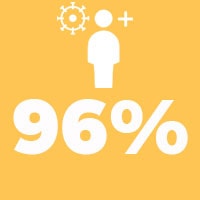Home
/
Scientific & Clinical Evidence
/
Clinical Studies
/
Preventing and Responding to COVID-19 on College Campuses
In simulations, colleges can prevent up to 96% of COVID-19 infections with common measures

A new study published in the Annals of Internal Medicine examined 24 combinations of four common preventative strategies: social distancing, mask wearing, testing and isolation, and calculated their effectiveness in students, faculty and surrounding community (including staff) and used a computer simulation model known as Clinical and Economic Analysis of COVID-19 interventions, or CEACOV, that simulated a semester of a mid-sized college (5,000 students and 1,000 faculty).
The study concluded:- About three of every four students and nearly one in six faculty would become infected over the semester in the absence of all mitigation efforts
- Minimal social distancing policies would only reduce infections by 16% in students
- While closing the campus and switching to online-only education would reduce infections by 63% among students, it would be less effective than opening the campus and implementing a mask-wearing and social distancing policy, which would reduce infections by 87% among students
- Two common measures: social distancing and mandatory masks prevents 87% of campus COVID-19 infections
- Adding routine lab-based testing to the mix would prevent 92% to 96% of infections
At a Glance
16 %
Social distancing policies reduce infections by 16% in students
87 %
Implementing a mask-wearing and social distancing policy can reduce infections by 87%
75 %
About three of every four students will be infected over the semester in the absence of mitigation efforts
To Read the Full Study: Click Here
Source: Case Western Reserve University. (2021, January 13). Colleges can prevent 96 percent of COVID-19 infections with common measures, study finds. ScienceDaily. Retrieved February 2, 2021 from www.sciencedaily.com/releases/2021/01/210113090906.htm
Disclaimer: Scientific articles are presented for educational purposes only and are not intended to promote any Beckman Coulter product or service. Opinions and conclusions are those of the respective authors and not Beckman Coulter.
Disclaimer: Scientific articles are presented for educational purposes only and are not intended to promote any Beckman Coulter product or service. Opinions and conclusions are those of the respective authors and not Beckman Coulter.
 English
English

